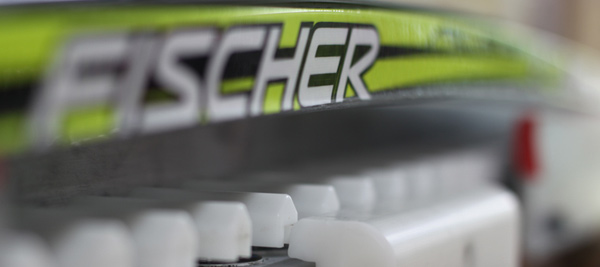K is called the spring constant and it varies
between different sets of skis, This however is a very
simplified picture of what is actually happening to the ski, but
it gets across the idea that energy is stored in the ski as
weight is applied to it. The energy causes the ski to change
shape. Skis of different flexes change shape differently to help
the skier move across the snow as fast as possible in the
conditions they are designed for.
Skate Skis
When designing a skate ski's flex there are three major things to consider: dry friction, capillary friction and stability. Depending on the snow conditions a ski is designed to deal with each of these to varying degrees.
Dry friction is dealt with by creating a ski that, when compressed, applies a large amount of the surface area of its base to the snow. Because friction is independent of area, this does not increase the friction. It does, however, decrease the pressure exerted on the snow.
Skate Skis

When designing a skate ski's flex there are three major things to consider: dry friction, capillary friction and stability. Depending on the snow conditions a ski is designed to deal with each of these to varying degrees.
Dry friction is dealt with by creating a ski that, when compressed, applies a large amount of the surface area of its base to the snow. Because friction is independent of area, this does not increase the friction. It does, however, decrease the pressure exerted on the snow.
P=F/A
As area (A) increases with a constant force
(F), pressure (P) will decrease. The large the pressure the
deeper the ski will dig into the snow, which does increase
the amount of force it takes to move the ski forward. In
very soft snow it is easier for a ski to sink in and so skis
designed for soft conditions also tend to have a larger snow
contact area.
Capillary friction is dealt with by creating a ski that applies a small amount of its base's surface area to the snow. The forces from the capillary action of water do depend on surface area. If less
of the ski is contacting the layer of water under the base
then the capillary forces will be smaller.
of water do depend on surface area. If less
of the ski is contacting the layer of water under the base
then the capillary forces will be smaller.
The larger pressure that a ski applies to the snow the more it will sink and the harder it will be to slide side to side making the ski stable. In conditions where capillary forces are large stability is generally not an issue since the pressure is higher. In conditions where dry friction is large the snow tends to be slow making it easier to control the ski and so stability isn't nearly as important. However, the proper combination of these attributes is essential for a ski to be able to be skied fast.
Classic Skis
A classic ski is similar, but slightly different from a skate ski. On a classic ski stability is not nearly as important since most of the time the skis are pointed parallel to the direction of motion. However, classic skis have a very sticky wax applied to the middle of the ski base. This wax allows the skier to achieve forward momentum when it touches the snow, but if it were in contact with snow the entire time it would slow the ski down. Classic ski flex also has to be designed so that when a skier is gliding with their weight centered between the two skis the kick wax does not touch the snow. When the skier shifts their weight so all of it falls onto one ski that ski should should compress the kick wax into the snow.
Capillary friction is dealt with by creating a ski that applies a small amount of its base's surface area to the snow. The forces from the capillary action
 of water do depend on surface area. If less
of the ski is contacting the layer of water under the base
then the capillary forces will be smaller.
of water do depend on surface area. If less
of the ski is contacting the layer of water under the base
then the capillary forces will be smaller.The larger pressure that a ski applies to the snow the more it will sink and the harder it will be to slide side to side making the ski stable. In conditions where capillary forces are large stability is generally not an issue since the pressure is higher. In conditions where dry friction is large the snow tends to be slow making it easier to control the ski and so stability isn't nearly as important. However, the proper combination of these attributes is essential for a ski to be able to be skied fast.
Classic Skis
A classic ski is similar, but slightly different from a skate ski. On a classic ski stability is not nearly as important since most of the time the skis are pointed parallel to the direction of motion. However, classic skis have a very sticky wax applied to the middle of the ski base. This wax allows the skier to achieve forward momentum when it touches the snow, but if it were in contact with snow the entire time it would slow the ski down. Classic ski flex also has to be designed so that when a skier is gliding with their weight centered between the two skis the kick wax does not touch the snow. When the skier shifts their weight so all of it falls onto one ski that ski should should compress the kick wax into the snow.
 Flex
Flex